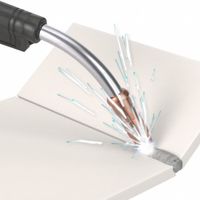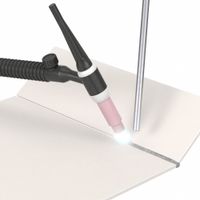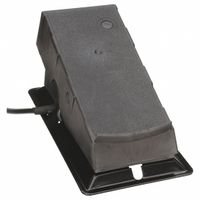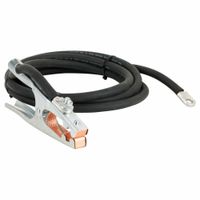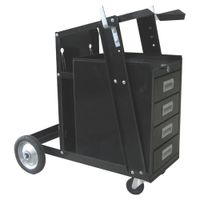Call +(254) 703 030 000 / 751 483 999 / 721 704 777
.....Read More
Frequently Asked Questions
What is arc welding used for?
Arc welding is a widely used technique for joining metals. It employs an electric arc to melt the workpieces and the filler material, creating a strong joint upon cooling. This method is essential in various industries due to its versatility, efficiency, and ability to produce high-strength welds.
In construction, arc welding is crucial for fabricating steel structures, bridges, and buildings. It ensures the integrity and durability of these structures by providing robust connections between metal components. The automotive industry relies on arc welding for assembling vehicle frames, exhaust systems, and other critical parts, ensuring safety and performance.
Manufacturing sectors use arc welding to produce machinery, equipment, and tools. It allows for precise and durable joints, essential for the longevity and functionality of manufactured products. In shipbuilding, arc welding is indispensable for constructing and repairing ships, submarines, and offshore platforms, where strong, watertight joints are vital.
The aerospace industry benefits from arc welding in the production and maintenance of aircraft and spacecraft. It provides the necessary strength and precision for components subjected to extreme conditions. Additionally, arc welding is used in pipeline construction and repair, ensuring leak-proof joints for transporting oil, gas, and water.
Arc welding is also employed in the repair and maintenance of metal structures and equipment, extending their service life and reducing costs. Its adaptability to various metals and alloys, including steel, aluminum, and titanium, makes it suitable for diverse applications.
Overall, arc welding is a fundamental process in industries requiring reliable and durable metal joints, contributing significantly to the construction, manufacturing, automotive, aerospace, and energy sectors.
How does MIG welding differ from TIG welding?
MIG (Metal Inert Gas) welding and TIG (Tungsten Inert Gas) welding are both arc welding processes that use an inert gas to protect the weld area from contamination. However, they differ in several key aspects:
1. **Electrode and Filler Material**:
- **MIG Welding**: Uses a consumable wire electrode that is continuously fed through the welding gun. The wire acts as both the electrode and the filler material, which melts to form the weld.
- **TIG Welding**: Uses a non-consumable tungsten electrode to produce the weld. A separate filler rod may be used if additional material is needed, but it is not always necessary.
2. **Shielding Gas**:
- **MIG Welding**: Typically uses a mixture of argon and carbon dioxide or pure argon as the shielding gas to protect the weld from atmospheric contamination.
- **TIG Welding**: Primarily uses pure argon or helium as the shielding gas, providing a cleaner weld with less spatter.
3. **Welding Technique**:
- **MIG Welding**: Generally easier to learn and faster, making it suitable for high-production environments. It is often used for welding thicker materials and is more forgiving of minor surface contaminants.
- **TIG Welding**: Requires more skill and precision, as the welder must manually feed the filler rod while controlling the torch. It is ideal for thin materials and applications requiring high-quality, precise welds.
4. **Applications**:
- **MIG Welding**: Commonly used in automotive, construction, and manufacturing industries for welding steel, stainless steel, and aluminum.
- **TIG Welding**: Preferred in aerospace, art, and industries requiring high-quality welds, such as for stainless steel, aluminum, and exotic metals.
5. **Weld Quality**:
- **MIG Welding**: Produces strong welds but may have more spatter and less aesthetic appeal.
- **TIG Welding**: Produces cleaner, more precise welds with a superior finish and minimal spatter.
What are the advantages of stick welding?
Stick welding, also known as Shielded Metal Arc Welding (SMAW), offers several advantages:
1. **Versatility**: Stick welding can be used on a wide range of metals, including steel, stainless steel, and cast iron. It is suitable for both thin and thick materials.
2. **Portability**: The equipment required for stick welding is relatively simple and portable, making it ideal for fieldwork and remote locations where access to power sources may be limited.
3. **Cost-Effective**: The initial investment in stick welding equipment is generally lower compared to other welding processes. Additionally, the electrodes used are relatively inexpensive.
4. **Simplicity**: The process is straightforward and does not require complex equipment or extensive training, making it accessible for beginners and hobbyists.
5. **All-Position Welding**: Stick welding can be performed in various positions, including flat, vertical, horizontal, and overhead, providing flexibility in different welding scenarios.
6. **Effective in Adverse Conditions**: Stick welding is less sensitive to wind and drafts compared to other welding methods, making it suitable for outdoor and harsh environments.
7. **Minimal Pre-Cleaning Required**: The process is tolerant of rust, dirt, and paint on the workpiece, reducing the need for extensive surface preparation.
8. **Strong Welds**: Stick welding produces strong and durable welds, which are suitable for structural applications and repairs.
9. **No Need for External Shielding Gas**: The flux coating on the electrode provides the necessary shielding, eliminating the need for external gas supplies and reducing equipment complexity.
10. **Wide Range of Electrodes**: A variety of electrodes are available, allowing for customization based on the specific requirements of the welding task, such as penetration depth and weld appearance.
When should I use TIG welding?
TIG welding, or Tungsten Inert Gas welding, is ideal for situations requiring precision, high-quality welds, and aesthetic appeal. It is best used when working with thin materials, such as stainless steel, aluminum, and other non-ferrous metals, where control over the heat input is crucial to prevent warping or burn-through. TIG welding is also preferred for projects demanding clean, spatter-free welds, as it produces minimal smoke and fumes, resulting in a cleaner work environment and weld appearance.
This method is suitable for applications where the weld's appearance is critical, such as in automotive, aerospace, and art projects, due to its ability to produce smooth, visually appealing welds. TIG welding is also advantageous when working on complex joints or intricate designs, as it allows for precise control over the welding arc and filler material, enabling the welder to create detailed and accurate welds.
Additionally, TIG welding is beneficial in situations where a high degree of weld integrity is required, such as in pressure vessels, pipelines, and critical structural components, due to its ability to produce strong, defect-free welds. It is also the preferred method for welding dissimilar metals, as it provides the flexibility to adjust the welding parameters to accommodate different material properties.
Overall, TIG welding should be used when precision, control, and high-quality welds are paramount, especially in applications involving thin materials, complex designs, or critical structural components.
What is the purpose of an engine-driven welder?
An engine-driven welder is a versatile piece of equipment designed to provide welding capabilities in locations where access to electricity is limited or unavailable. Its primary purpose is to generate the necessary power to operate welding tools and equipment independently of an external power source. This is achieved through an integrated engine, typically powered by gasoline, diesel, or propane, which drives an alternator to produce electricity.
The engine-driven welder is particularly valuable in remote or off-grid locations, such as construction sites, pipelines, shipyards, and agricultural settings, where traditional power sources are not feasible. It allows for on-site fabrication, repair, and maintenance work, enhancing productivity and reducing downtime by eliminating the need to transport materials to a workshop with electrical access.
In addition to welding, many engine-driven welders are equipped with auxiliary power outlets, enabling them to function as portable generators. This feature allows them to power additional tools and equipment, such as grinders, drills, and lights, further increasing their utility on job sites.
Engine-driven welders are available in various sizes and power outputs, catering to different welding processes, including stick, MIG, TIG, and flux-cored welding. Their portability and self-sufficiency make them indispensable for professionals who require reliable and flexible welding solutions in challenging environments.
How does a multiprocess welder work?
A multiprocess welder is a versatile welding machine designed to perform various types of welding processes, such as MIG (Metal Inert Gas), TIG (Tungsten Inert Gas), and Stick welding, among others. It operates by utilizing different welding techniques, each suited for specific materials and applications, allowing the user to switch between processes without needing multiple machines.
The core of a multiprocess welder is its power source, which can be either an inverter or a transformer. Inverter-based models are more common due to their efficiency, lightweight design, and ability to provide a stable arc. The power source converts the input electrical current into the appropriate output for the selected welding process.
For MIG welding, the machine feeds a continuous wire electrode through a welding gun, while a shielding gas is simultaneously released to protect the weld pool from atmospheric contamination. The user can adjust parameters like voltage and wire feed speed to suit the material and thickness being welded.
In TIG welding, the machine uses a non-consumable tungsten electrode to produce the weld. The user manually feeds a filler rod into the weld pool, while a shielding gas, typically argon, protects the weld area. TIG welding is known for its precision and is often used for thin materials and critical welds.
Stick welding, or Shielded Metal Arc Welding (SMAW), involves using a consumable electrode coated in flux. The flux creates a gas shield when melted, protecting the weld from contaminants. This process is versatile and effective for outdoor and less controlled environments.
A multiprocess welder typically features a user-friendly interface, allowing the operator to select the desired welding mode and adjust settings accordingly. This adaptability makes it ideal for workshops, repair jobs, and situations requiring different welding techniques.
What materials can be welded with TIG welding?
TIG welding, or Tungsten Inert Gas welding, is a versatile welding process that can be used to weld a wide range of materials. The primary materials that can be welded using TIG welding include:
1. **Stainless Steel**: TIG welding is highly effective for stainless steel, providing clean and precise welds. It is commonly used in industries where corrosion resistance and aesthetic appearance are important.
2. **Aluminum**: Due to its excellent control over heat input, TIG welding is ideal for aluminum, which requires careful handling to prevent warping and cracking. It is widely used in the automotive and aerospace industries.
3. **Carbon Steel**: TIG welding can be used for carbon steel, offering strong and durable welds. It is suitable for both thin and thick sections, making it versatile for various applications.
4. **Magnesium**: TIG welding is suitable for magnesium and its alloys, often used in the aerospace and automotive industries due to their lightweight properties.
5. **Copper and Copper Alloys**: TIG welding can effectively weld copper and its alloys, such as bronze and brass, which are used in electrical and plumbing applications.
6. **Nickel and Nickel Alloys**: These materials are often used in high-temperature and corrosive environments, and TIG welding provides the necessary precision and control.
7. **Titanium**: Known for its strength and corrosion resistance, titanium is commonly used in aerospace and medical applications. TIG welding is preferred for its ability to produce high-quality welds without contamination.
8. **Exotic Alloys**: TIG welding is also suitable for welding exotic and specialized alloys used in various high-performance applications.
TIG welding is favored for its precision, control, and ability to produce high-quality welds across a diverse range of materials, making it a preferred choice in industries requiring high standards of weld integrity.
Why is MIG welding faster than TIG welding?
MIG welding, or Metal Inert Gas welding, is generally faster than TIG welding, or Tungsten Inert Gas welding, due to several key factors:
1. **Automation and Continuous Feed**: MIG welding uses a continuously fed wire electrode, which allows for uninterrupted welding. This continuous feed reduces downtime associated with stopping to replace electrodes, as is common in TIG welding, where the welder must manually feed filler material.
2. **Ease of Use**: MIG welding is easier to learn and operate, allowing welders to work more quickly. The process is more forgiving of minor errors in technique, enabling faster progress without compromising weld quality.
3. **Higher Deposition Rates**: MIG welding typically has higher deposition rates compared to TIG welding. This means more material can be deposited in a shorter amount of time, speeding up the welding process.
4. **Less Skill-Intensive**: TIG welding requires a high level of skill and precision, as the welder must manually control the filler rod and maintain a stable arc. This precision slows down the process. In contrast, MIG welding is more straightforward, allowing for faster operation.
5. **Suitability for Thicker Materials**: MIG welding is better suited for thicker materials and larger projects, where speed is a priority. It can handle a variety of material thicknesses without the need for multiple passes, unlike TIG welding, which is often used for thinner materials and requires more precision.
6. **Reduced Preparation Time**: MIG welding requires less surface preparation and cleaning compared to TIG welding, which demands cleaner surfaces for high-quality welds. This reduction in preparation time contributes to overall faster welding.
These factors collectively make MIG welding a faster process compared to TIG welding, especially in industrial and high-production environments.
Can stick welding be used outdoors?
Yes, stick welding, also known as Shielded Metal Arc Welding (SMAW), can be effectively used outdoors. It is one of the most versatile welding processes suitable for outdoor conditions due to several reasons:
1. **Wind Resistance**: Stick welding uses a consumable electrode coated with flux, which generates a gas shield when melted. This shield protects the weld pool from atmospheric contamination. Unlike other welding methods like MIG or TIG, which rely on external gas shielding, stick welding is less susceptible to wind interference, making it ideal for outdoor use.
2. **Portability**: Stick welding equipment is generally more portable and less complex than other welding setups. This makes it easier to transport and set up in various outdoor locations, including remote or hard-to-reach areas.
3. **Versatility**: Stick welding can be used on a wide range of materials and thicknesses, including steel, stainless steel, and cast iron. It is suitable for various outdoor applications, such as construction, pipeline work, and repair jobs.
4. **Durability**: The process is robust and can handle less-than-ideal conditions, such as dirty or rusty surfaces, which are common in outdoor environments. This makes it a practical choice for maintenance and repair work.
5. **Cost-Effectiveness**: Stick welding equipment is generally less expensive than other welding systems, and the electrodes are relatively affordable, making it a cost-effective option for outdoor projects.
However, it is important to consider safety precautions, such as wearing appropriate protective gear and ensuring a stable power supply, to mitigate risks associated with outdoor welding.
What are the benefits of using a multiprocess welder?
A multiprocess welder offers several benefits, making it a versatile and efficient tool for various welding tasks:
1. **Versatility**: It combines multiple welding processes such as MIG, TIG, and Stick in one machine, allowing users to switch between different welding techniques without needing separate equipment.
2. **Cost-Effective**: Investing in a single multiprocess welder is often more economical than purchasing multiple machines for different welding processes, reducing overall equipment costs.
3. **Space-Saving**: A multiprocess welder consolidates multiple machines into one, saving valuable workspace in workshops or garages, which is particularly beneficial for small or mobile operations.
4. **Convenience**: Users can easily switch between welding processes, enhancing productivity and reducing downtime. This flexibility is ideal for projects requiring different welding techniques.
5. **Portability**: Many multiprocess welders are designed to be lightweight and portable, making them suitable for on-site jobs and repairs where mobility is crucial.
6. **Ease of Use**: Modern multiprocess welders often come with user-friendly interfaces and settings, making them accessible to both beginners and experienced welders.
7. **Improved Efficiency**: By having all necessary welding processes in one machine, operators can streamline their workflow, leading to faster project completion times.
8. **Adaptability**: These welders can handle a wide range of materials and thicknesses, making them suitable for diverse applications in industries such as automotive, construction, and manufacturing.
9. **Reduced Maintenance**: Maintaining one multiprocess welder is generally simpler and less costly than maintaining multiple single-process machines.
10. **Advanced Features**: Many multiprocess welders come equipped with advanced features like digital displays, automatic settings, and memory functions, enhancing precision and control.
Overall, a multiprocess welder provides flexibility, efficiency, and cost savings, making it an attractive option for both hobbyists and professional welders.


